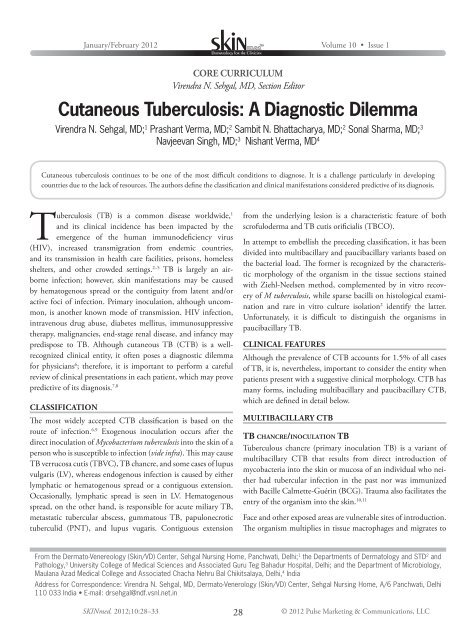January/February 2012 • Volume 10 • Issue 1 - SKINmed Journal
January/February 2012 • Volume 10 • Issue 1 - SKINmed Journal
January/February 2012 • Volume 10 • Issue 1 - SKINmed Journal
Create successful ePaper yourself
Turn your PDF publications into a flip-book with our unique Google optimized e-Paper software.
<strong>January</strong>/<strong>February</strong> <strong>2012</strong> <strong>Volume</strong> <strong>10</strong> <strong>•</strong> <strong>Issue</strong> 1<br />
Tuberculosis (TB) is a common disease worldwide, 1<br />
and its clinical incidence has been impacted by the<br />
emergence of the human immunodeficiency virus<br />
(HIV), increased transmigration from endemic countries,<br />
and its transmission in health care facilities, prisons, homeless<br />
shelters, and other crowded settings. 2–5 TB is largely an airborne<br />
infection; however, skin manifestations may be caused<br />
by hematogenous spread or the contiguity from latent and/or<br />
active foci of infection. Primary inoculation, although uncommon,<br />
is another known mode of transmission. HIV infection,<br />
intravenous drug abuse, diabetes mellitus, immunosuppressive<br />
therapy, malignancies, end-stage renal disease, and infancy may<br />
predispose to TB. Although cutaneous TB (CTB) is a well-<br />
recognized clinical entity, it often poses a diagnostic dilemma<br />
for physicians 6 ; therefore, it is important to perform a careful<br />
review of clinical presentations in each patient, which may prove<br />
predictive of its diagnosis. 7,8<br />
CLASSIFICATION<br />
The most widely accepted CTB classification is based on the<br />
route of infection. 6,9 Exogenous inoculation occurs after the<br />
direct inoculation of Mycobacterium tuberculosis into the skin of a<br />
person who is susceptible to infection (vide infra). This may cause<br />
TB verrucosa cutis (TBVC), TB chancre, and some cases of lupus<br />
vulgaris (LV), whereas endogenous infection is caused by either<br />
lymphatic or hematogenous spread or a contiguous extension.<br />
Occasionally, lymphatic spread is seen in LV. Hematogenous<br />
spread, on the other hand, is responsible for acute miliary TB,<br />
metastatic tubercular abscess, gummatous TB, papulonecrotic<br />
tuberculid (PNT), and lupus vugaris. Contiguous extension<br />
CORE CURRICULUM<br />
Virendra N. Sehgal, MD, Section Editor<br />
Cutaneous Tuberculosis: A Diagnostic Dilemma<br />
Virendra N. Sehgal, MD; 1 Prashant Verma, MD; 2 Sambit N. Bhattacharya, MD; 2 Sonal Sharma, MD; 3<br />
Navjeevan Singh, MD; 3 Nishant Verma, MD 4<br />
Cutaneous tuberculosis continues to be one of the most difficult conditions to diagnose. It is a challenge particularly in developing<br />
countries due to the lack of resources. The authors define the classification and clinical manifestations considered predictive of its diagnosis.<br />
from the underlying lesion is a characteristic feature of both<br />
scrofuloderma and TB cutis orificialis (TBCO).<br />
In attempt to embellish the preceding classification, it has been<br />
divided into multibacillary and paucibacillary variants based on<br />
the bacterial load. The former is recognized by the characteristic<br />
morphology of the organism in the tissue sections stained<br />
with Ziehl-Neelsen method, complemented by in vitro recovery<br />
of M tuberculosis, while sparse bacilli on histological examination<br />
and rare in vitro culture isolation 2 identify the latter.<br />
Unfortunately, it is difficult to distinguish the organisms in<br />
paucibacillary TB.<br />
CLINICAL FEATURES<br />
Although the prevalence of CTB accounts for 1.5% of all cases<br />
of TB, it is, nevertheless, important to consider the entity when<br />
patients present with a suggestive clinical morphology. CTB has<br />
many forms, including multibacillary and paucibacillary CTB,<br />
which are defined in detail below.<br />
MULTIBACILLARY CTB<br />
TB CHANCRE/INOCULATION TB<br />
Tuberculous chancre (primary inoculation TB) is a variant of<br />
multibacillary CTB that results from direct introduction of<br />
mycobacteria into the skin or mucosa of an individual who neither<br />
had tubercular infection in the past nor was immunized<br />
with Bacille Calmette-Guérin (BCG). Trauma also facilitates the<br />
entry of the organism into the skin. <strong>10</strong>,11<br />
Face and other exposed areas are vulnerable sites of introduction.<br />
The organism multiplies in tissue macrophages and migrates to<br />
From the Dermato-Venereology (Skin/VD) Center, Sehgal Nursing Home, Panchwati, Delhi; 1 the Departments of Dermatology and STD2 and<br />
Pathology, 3 University College of Medical Sciences and Associated Guru Teg Bahadur Hospital, Delhi; and the Department of Microbiology,<br />
Maulana Azad Medical College and Associated Chacha Nehru Bal Chikitsalaya, Delhi, 4 India<br />
Address for Correspondence: Virendra N. Sehgal, MD, Dermato-Venerology (Skin/VD) Center, Sehgal Nursing Home, A/6 Panchwati, Delhi<br />
1<strong>10</strong> 033 India <strong>•</strong> E-mail: drsehgal@ndf.vsnl.net.in<br />
<strong>SKINmed</strong>. <strong>2012</strong>;<strong>10</strong>:28–33 28<br />
© <strong>2012</strong> Pulse Marketing & Communications, LLC


